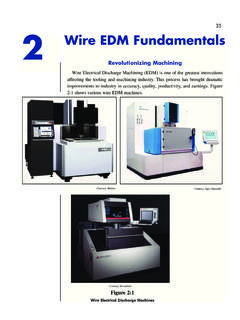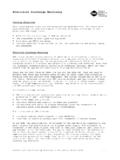Transcription of 81 5 EDM Process Understanding the Wire
1 81. 5 Understanding the wire EDM Process Accuracy and Tolerances wire EDM is extremely accurate. Many machines move in increments of 40. millionths of an inch (.00004") (.001 mm), some in 10 millionths of an inch (.00001"). (.00025 mm), and others even in 4 millionths of an inch (.000004 ) (.0001 mm). Machines can achieve accuracies of + (.0025 mm); however, skim cuts need to be made to obtain such tolerances. See Figure 5:1. Courtesy Agie Figure 5:1. Precision wire EDMing Finishes Extremely fine finishes of 12 rms can be produced with wire EDM. wire EDM. produces an excellent finish, even in the so-called rough cut." Customers are often amazed when shown the fine finish of a single-pass cut.
2 This fine finish is present, even after very large parts are cut, as in Figure 5:2. In other cutting operations, such as lasers and abrasive water jet, the larger the part, the rougher the finish. wire EDM produces a smooth finish because the wire electrode goes through the entire part, and spark erosion occurs along the entire wire electrode. Complete EDM Handbook 82 Compliments of Figure 5:2. Showpiece: 16 Inches (406 mm) Tall Cut at Reliable EDM. (Reliable Can wire EDM Parts Up to 64" (1626 mm) Tall). wire Path A. wire Kerf the wire never contacts the workpiece. If the wire would contact the workpiece, there would be a short circuit and no cutting would occur.
3 the wire electrode cuts by means of spark erosion, thereby leaving a path slightly larger than the wire . A. commonly used wire , .012" (.30 mm), usually creates a .016" (.41 mm) kerf, as shown in Figure 5:3. Thinner wires have smaller kerfs. B. Corners and Radii .016" (.41mm). Kerf .012 (.30 mm) Diameter wire Figure 5:3. wire Kerf Understanding the wire EDM Process 83. When the wire turns a corner, it can produce a sharp edge on the outside corner, but it will always leave a small radius on the inside corner, as demonstrated in Figure 5:4. The size of this radius is determined by the wire diameter plus the spark gap. To produce very sharp outside corners, skim cuts are made.
4 Having small corner radii on the outside corners can prevent the need for skim cuts; this also reduces wire EDM costs. In stamping dies, sharp corners usually wear first, so a small outside radius is preferable. The minimum inside radius for .012" (.30 mm) wire is .0063" (.016 mm), and the minimum radius for .010" wire (.25 mm) is .0053" (.13 mm). These small radii are achieved by skimming. Smaller radii are possible with thinner wire ; however, most work is done with thicker wires because thinner wire cuts slower. Radius .0063..012 wire Corner Can be Sharp Figure 5:4. Inside and Outside Corners Skim Cutting For most jobs, the initial cut is sufficient for both finish and accuracy.
5 However, for precision parts, skim cuts achieve greater accuracy and a finer finish. There are three main reasons for skim cuts: Barreling effect and wire trail-off Metal movement Finishes and accuracy Complete EDM Handbook 84 Compliments of A. Barreling Effect and wire Trail-Off There is a .002" to .003" (. mm) gap between the wire and the workpiece. (Gap is determined by the intensity of the spark energy.) In this gap, a controlled localized eruption takes place. The force of the spark and the gases trying to escape causes a slight barreling. On thick workpieces, this barreling causes the center to be slightly hollow. See Figure 5:5. Direction of Travel Actual Cut Slight Hollow on First Cut Figure 5:5.
6 First Cut Corner Conditions When cutting sharp corners, the wire dwells longer by the inside radius, causing a slight overcut; on the outside radius, it speeds, leaving a slight undercut, as illustrated in Figure 5:6. That is why most new machines have a slow down program for corner cutting. To achieve maximum corner profiles; however, skim cutting is recommended. Direction of Travel .016". Slight Overcut Because wire Dwells Longer Slight Undercut Because wire Goes Faster Around Corner Figure 5:6. Skim Cutting is Used for Very Close Tolerances. A trail-off is produced when the machine cuts a corner. A slight amount of material is left behind for a short distance before the wire returns to its programmed path.
7 For most jobs, this slight undercut is negligible. Understanding the wire EDM Process 85. The sharper the corner, the greater the overcut and undercut. The accuracy of the part determines the need for skim cutting. To avoid most of this barreling effect and wire trail-off, some wire EDM machines automatically slow down in corner cutting. Nevertheless, high precision parts still require skim cuts. B. Metal Movement Even though metal has been stress relieved, it may move after the part has been cut with wire EDM because the stresses within the metal were not totally removed in stress relieving. If metal has moved due to inherent stresses, and the part requires to be precise, then skim cuts are used to bring the part into tolerance.
8 The accuracies called for by the print determine the number of skim cuts. C. Finishes and Accuracy First cuts produce a fine finish; however, sometimes a finer finish and greater accuracies are required. To accomplish this, skim cuts are used. See Figure 5:7 for a general view of the various finishes that can be produced with wire EDM. (Some machines produce different results.). RMS. Finish A B C D E . Accuracy 60 (depending on thickness of material). 45. 30 .0004 Accuracy 15 .0002 Accuracy High Speed 1st 2nd 3rd 4th Cut Skim Skim Skim Skim Figure 5:7. Approximate Accuracies and Finishes Cut A For most jobs, this finish and accuracy are more than adequate.
9 Cuts B-E Depending on accuracy and finish required, various skim cuts are performed. Complete EDM Handbook 86 Compliments of Skim cutting produces fine finishes because less energy is applied to the wire which creates smaller sparks and thus smaller cavities. These small sparks produce extremely fine finishes, and on some machines mirror finishes. Carbide Tungsten carbide, third in hardness to diamond and boron carbide, is an extremely difficult material to machine. Except for diamond cutting tools and diamond impregnated grinding wheels, EDM presents the only practical method to machine this hardened material. To bind tungsten carbide when it is sintered, cobalt is added.
10 The amount of cobalt, from 6 to 15 percent, determines the hardness and toughness of the carbide. The electrical conductivity of cobalt exceeds that of tungsten, so EDM erodes the cobalt binder in tungsten carbide. The carbide granules fall out of the compound during cutting, so the amount of cobalt binder determines the wire EDM speed, and the energy applied during the cutting determines the depth of binder that is removed. When cutting carbide on certain wire EDM machines, the initial first cut can cause surface micro-cracks. To eliminate them, skim cuts are used. However, at our company, Reliable EDM, we have repeatedly cut carbide parts with a single cut.



